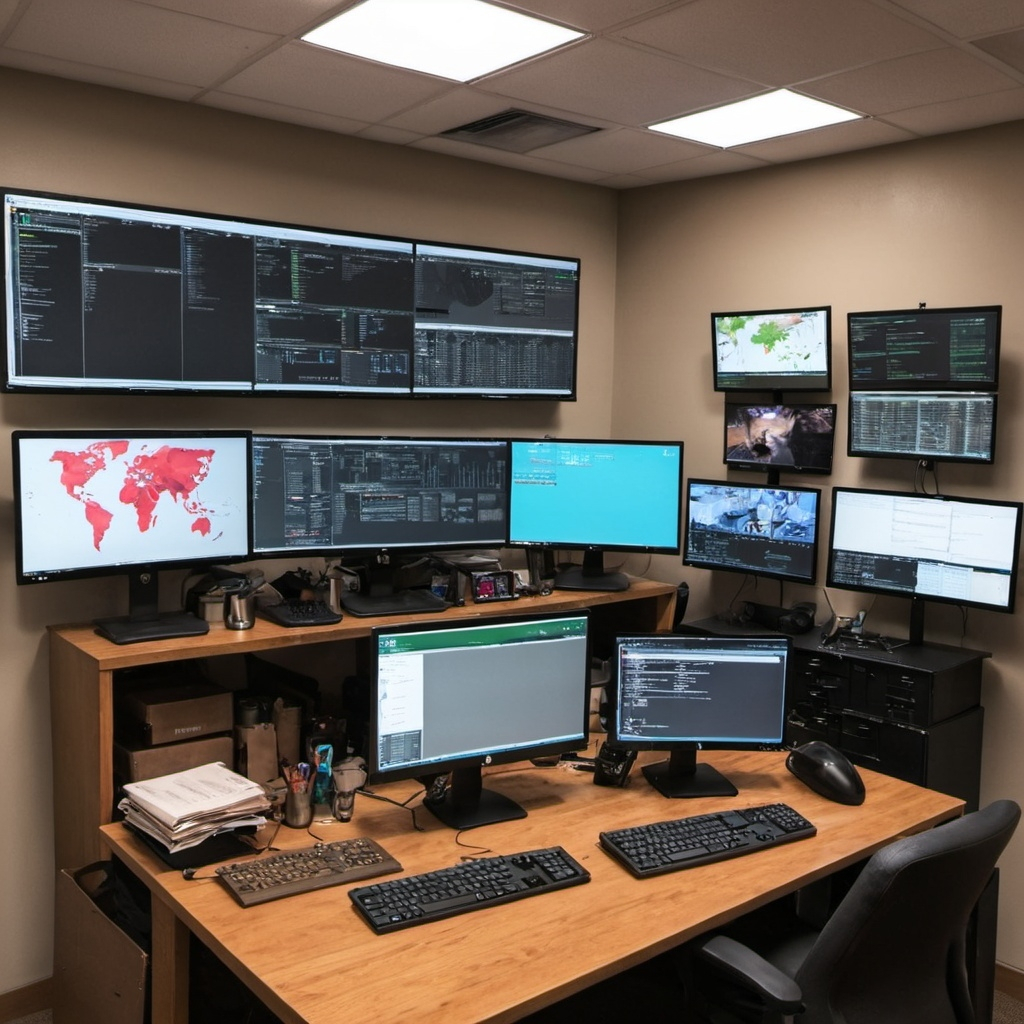Well In the context of software development, a war room setup refers to a collaborative space or environment where a team of software developers, testers, project managers, and other stakeholders come together to address critical issues, resolve problems, and accelerate the development process. It is a dedicated space where the team focuses on a specific project or task, often during a crucial phase of development or when there is a need for intense collaboration and problem-solving.
The purpose of a software development war room is to foster open communication, enhance collaboration, and facilitate rapid decision-making. It provides a centralized location where team members can share ideas, brainstorm solutions, and work together to overcome obstacles.
In a software development war room setup, the physical space may include whiteboards, large display screens, project management tools, and other resources to facilitate effective communication and information sharing. The room is typically designed to encourage a high-energy, focused atmosphere, where team members can easily interact, exchange knowledge, and quickly resolve issues. The war room setup is particularly useful during critical phases of software development, such as bug fixing, troubleshooting, performance optimization, or addressing urgent customer requests. By bringing together key stakeholders in a dedicated space, the team can collaborate closely, address challenges in real-time, and make decisions more efficiently, ultimately accelerating the development process and improving the overall quality of the software product.
Understanding what war rooms are
A war room setup typically refers to a dedicated space or facility where individuals gather to make critical decisions, coordinate actions, and respond to urgent or high-stakes situations. It is commonly used in military operations, crisis management, emergency response, and large-scale projects.
The term “war room” originates from military command centers where military strategists, commanders, and other personnel analyze data, monitor operations, and plan tactical maneuvers during a war. The concept has since been adopted in various other domains.
In a war room setup, the physical space is often equipped with advanced communication and information technology systems, including large display screens, video conferencing capabilities, real-time data feeds, and collaboration tools. This infrastructure allows participants to access relevant information, analyze data, share insights, and communicate effectively with team members and stakeholders.
The purpose of a war room setup is to facilitate rapid decision-making, enhance situational awareness, and ensure efficient coordination among team members. It serves as a central hub where key personnel can gather, assess information, strategize, and execute plans in a time-sensitive and dynamic environment.
War rooms are commonly used in crisis situations such as natural disasters, major business disruptions, cybersecurity incidents, or complex projects with tight timelines. By bringing together experts from different disciplines or departments, a war room setup enables cross-functional collaboration, fosters collective intelligence, and helps organizations respond swiftly and effectively to challenges.

When to setup a war room
War rooms in software development can be set up at various points in time, depending on the specific needs and circumstances of the project. Here are some common scenarios when setting up a war room can be beneficial:
- Critical Project Phases: War rooms are often established during critical phases of a project that require intensive collaboration and problem-solving. This can include activities such as system integration, performance optimization, or resolving high-priority issues before a major release.
- Major Bug Fixes or Escalations: If a critical bug is identified that requires immediate attention or if there is a customer escalation, setting up a war room can help bring together the necessary expertise to quickly diagnose and resolve the issue.
- Production Incidents: When a significant production incident occurs, and the system is experiencing downtime or severe disruptions, establishing a war room allows for a focused response. The team can work together to mitigate the incident, identify the root cause, and restore normal operations.
- Tight Deadlines or High-Stakes Projects: Projects with tight deadlines or those involving high stakes, such as a major product launch or a critical client delivery, can benefit from a war room setup. It helps ensure effective coordination, rapid decision-making, and close collaboration among team members.
- Crisis or Emergency Situations: In the event of a crisis or emergency, such as a cybersecurity breach, natural disaster, or significant data loss, a war room can be quickly established to respond to the situation, manage the incident, and coordinate recovery efforts.
- Continuous Improvement Initiatives: War rooms can also be set up as part of ongoing improvement initiatives, such as implementing DevOps practices, optimizing software development workflows, or addressing persistent quality issues. The war room serves as a dedicated space for focused efforts and collaborative problem-solving.
One must note that the decision to set up a war room should be based on the specific needs and urgency of the situation. It may not be necessary for every project or situation but can be a valuable tool when there is a need for intensive collaboration, rapid decision-making, and close coordination among team members.
Does it help
Of-course if you are planning a thing to be completed at war level footing it is bound to help. And, war rooms can be highly beneficial in software development and other domains where they are implemented. Here are some ways in which war rooms can help:
1. Enhanced Collaboration: War rooms bring together team members from different disciplines, allowing for improved collaboration and knowledge sharing. Being in the same physical space promotes face-to-face interactions, leading to better communication and shared understanding among team members.
2. Rapid Decision-making: With key stakeholders present in the war room, decisions can be made quickly and effectively. Immediate access to information, real-time discussions, and collective brainstorming enable faster decision-making, reducing bottlenecks and keeping projects on track.
3. Improved Problem-solving: War rooms provide an environment conducive to problem-solving. Team members can discuss issues, share insights, and combine their expertise to resolve complex problems more efficiently. The collaborative nature of war rooms often leads to innovative solutions.
4. Increased Focus and Productivity: By creating a dedicated space for a specific project or task, war rooms help minimize distractions and interruptions. Team members can focus on the project at hand, resulting in increased productivity and faster progress.

5. Heightened Situational Awareness: War rooms often incorporate real-time monitoring and visual displays of critical metrics, project status, or performance indicators. This enhances situational awareness, allowing the team to quickly identify issues, track progress, and make data-driven decisions.
6. Team Alignment and Engagement: War rooms foster a sense of shared purpose and collective ownership of the project. Team members feel more engaged and connected to the project’s goals and are more likely to collaborate effectively and go the extra mile to achieve success.
7. Crisis Management and Mitigation: In times of crises, war rooms provide a centralized hub for managing incidents, coordinating response efforts, and minimizing the impact on the project or organization. Rapid response and efficient crisis management are facilitated by having the relevant personnel in close proximity.
8. Continuous Improvement: War rooms also serve as a platform for continuous improvement initiatives. By bringing together experts and stakeholders, teams can identify areas for optimization, implement iterative changes, and foster a culture of learning and growth.
While war rooms are not a one-size-fits-all solution and may not be necessary for every project or situation, their structured and collaborative approach can significantly enhance teamwork, problem-solving, and decision-making in software development and other domains.
Activities that get converted to action items
A war room setup in software development involves various activities aimed at facilitating collaboration, problem-solving, and decision-making. Here are some common activities that form a part of a software development war room:
- Issue Triage: Team members gather to identify and prioritize critical issues, such as software defects, performance bottlenecks, or customer-reported problems. They analyze the severity, impact, and urgency of each issue and allocate resources accordingly.
- Collaborative Troubleshooting: The team collectively investigates and troubleshoots complex technical problems. They analyze log files, review code snippets, examine system configurations, and use debugging tools to identify the root cause of issues.
- Rapid Decision-making: The war room provides a forum for quick decision-making. Team members discuss available options, evaluate trade-offs, and make decisions promptly to keep the development process moving forward.
- Agile Planning and Stand-up Meetings: The war room serves as a central location for agile planning meetings, including daily stand-ups. Team members share progress updates, discuss impediments, and plan their activities for the day, fostering transparency and alignment.
- Cross-functional Collaboration: In the war room, developers, testers, project managers, designers, and other stakeholders collaborate closely. They share knowledge, leverage their diverse expertise, and work together to address challenges and optimize the software development process.
- Real-time Monitoring and Feedback: The war room may have screens displaying real-time metrics, such as build statuses, test results, performance data, or customer feedback. This enables the team to monitor progress, identify trends, and make data-driven decisions.
- Agile Retrospectives: The war room provides a conducive environment for conducting retrospectives, where the team reflects on the recent sprint or iteration, identifies areas for improvement, and defines action items to enhance future development cycles.
- Continuous Integration and Deployment: In a war room setup, continuous integration and deployment processes are often streamlined. The team focuses on automating build, test, and deployment pipelines to ensure fast and reliable software delivery.
- Emergency Response: The war room is prepared to handle urgent situations or critical incidents, such as system outages, security breaches, or customer escalations. The team quickly assembles to mitigate the issue, coordinate the response, and restore normal operations.
These activities promote collaboration, transparency, and agility within the software development team, enabling them to address challenges effectively, make informed decisions, and deliver high-quality software efficiently.
War room management
Managing a war room effectively requires careful planning, coordination, and leadership. Here are some key aspects to consider when managing a war room in software development:

- Define Clear Objectives: Clearly define the purpose and objectives of the war room. Determine the specific problems or challenges that need to be addressed and communicate them to the team. Ensure everyone understands the goals and priorities.
- Assemble the Right Team: Identify and bring together the right mix of individuals with the necessary skills and expertise to tackle the specific challenges at hand. Include developers, testers, project managers, subject matter experts, and other relevant stakeholders.
- Establish Communication Channels: Set up efficient communication channels within the war room. Ensure that team members can easily share information, collaborate, and discuss progress. Consider using project management tools, real-time messaging platforms, and video conferencing solutions.
- Provide Essential Resources: Equip the war room with the necessary resources and tools. This includes whiteboards, large screens or monitors, project documentation, relevant software and hardware, and access to development and testing environments.
- Set Clear Roles and Responsibilities: Clearly define the roles and responsibilities of each team member. Establish who will be responsible for coordinating activities, making decisions, documenting progress, and communicating updates.
- Foster Collaboration and Engagement: Create an environment that encourages collaboration, open dialogue, and active participation. Encourage team members to share ideas, ask questions, and contribute their expertise. Promote a positive and inclusive atmosphere.
- Implement Agile Practices: Embrace agile practices within the war room. Conduct daily stand-up meetings to keep everyone aligned and address any obstacles. Conduct regular retrospectives to reflect on what worked well and what can be improved.
- Monitor Progress and Metrics: Use visual dashboards or screens to display real-time progress, metrics, and key performance indicators. This helps the team stay informed about the status of tasks, test results, and overall project health.
- Facilitate Decision-making: Create a decision-making framework within the war room. Encourage open discussions, gather input from team members, and involve relevant stakeholders when making important decisions. Strive for consensus whenever possible.
- Document and Share Learnings: Keep track of key decisions, actions, and outcomes in the war room. Document lessons learned, best practices, and valuable insights. Share these with the wider team and use them to improve future projects.
- Adapt and Evolve: Remain flexible and adaptable in managing the war room. Adjust strategies, processes, and resources as needed based on the evolving requirements and challenges. Continuously seek feedback from team members and iterate on the approach.
By effectively managing a war room, you can maximize collaboration, accelerate problem-solving, and drive successful outcomes in software development projects.

Do away with war room
War rooms can be done away with when the specific need or circumstances that led to their establishment no longer exist. Here are a few scenarios where war rooms can be phased out:
1. Project Completion: Once a project is successfully completed, and there are no immediate critical issues or ongoing maintenance requirements, the war room can be disbanded. The need for intense collaboration and rapid decision-making diminishes as the project enters a maintenance or support phase.
2. Stable Operations: If the software or system has reached a stable state with minimal issues and routine operations are running smoothly, the war room may no longer be necessary. Ongoing monitoring and maintenance can typically be managed through regular channels without the need for a dedicated war room.
3. Crisis Resolution: War rooms are often established during crisis situations or emergencies. Once the crisis has been effectively managed, and the system is restored to normal operations, the war room can be disbanded as the immediate need for intense coordination and response diminishes.
4. Project Transition: When a project transitions from a high-intensity development phase to a maintenance or support phase, the war room may no longer be required. The focus shifts to regular maintenance activities, and collaboration can occur through established communication channels.
5. Agile Practices: In Agile software development methodologies, teams often have daily stand-up meetings and ongoing collaboration as part of their regular process. In such cases, a dedicated war room setup may not be necessary as the necessary communication and coordination are already built into the team’s practices.
It’s important to assess the ongoing needs and project dynamics to determine when a war room is no longer required. However, it’s worth noting that war rooms can be reestablished if new challenges or critical situations arise in the future that necessitate intense collaboration and focused problem-solving.





Introducing to you the most prestigious online entertainment address today. Visit now to experience now!
Please let me know if you’re looking for a writer for
your weblog. You have some really good articles and I think I
would be a good asset. If you ever want to take some of the load off, I’d absolutely
love to write some articles for your blog in exchange for
a link back to mine. Please blast me an e-mail if interested.
Thanks!
Please let me know if you’re looking for a writer for
your weblog. You have some really good articles and I think I would be a good asset.
If you ever want to take some of the load off, I’d absolutely love to write some articles for your
blog in exchange for a link back to mine. Please blast me an e-mail if interested.
Thanks! https://kvia.com/news/2022/06/30/radioshacks-nsfw-twitter-account-explained/
Hello! I could have sworn I’ve been to this blog before but after looking at some of the posts I realized it’s new to me. Anyhow, I’m definitely delighted I stumbled upon it and I’ll be bookmarking it and checking back regularly.
que eu mesmo criei ou terceirizei, mas parece que
muito dele está a aparecer em toda a Internet sem o meu acordo.
Díky moc!|Hej, jeg synes, dette er en fremragende blog. Jeg snublede over det;
Conhecem algum método para ajudar a evitar que o conteúdo seja roubado? Agradecia imenso.
Woah! I’m really digging the template/theme of this site. It’s simple, yet effective. A lot of times it’s tough to get that “perfect balance” between user friendliness and visual appeal. I must say you’ve done a superb job with this. Also, the blog loads extremely quick for me on Opera. Excellent Blog!
Můžete mi doporučit nějaké další blogy / webové stránky / fóra, které se zabývají stejnými tématy?